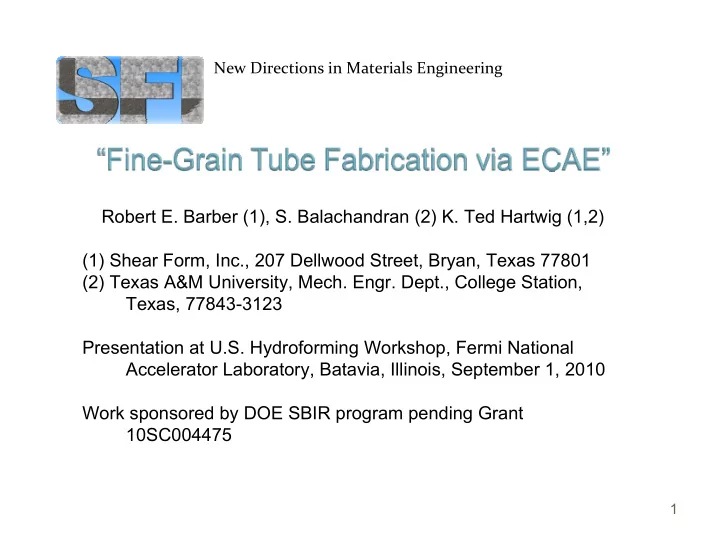

New Directions in Materials Engineering Robert E. Barber (1), S. Balachandran (2) K. Ted Hartwig (1,2) (1) Shear Form, Inc., 207 Dellwood Street, Bryan, Texas 77801 (2) Texas A&M University, Mech. Engr. Dept., College Station, Texas, 77843-3123 Presentation at U.S. Hydroforming Workshop, Fermi National Accelerator Laboratory, Batavia, Illinois, September 1, 2010 Work sponsored by DOE SBIR program pending Grant 10SC004475 1
Shear Form, Inc. Shear Form, Inc. � Mission: � To sell equipment for equal channel angular extrusion, ECAE process materials, and provide superior fine grain products for challenging applications. � Staff � Dr. K. Ted Hartwig, P.E., President � Robert E. Barber, P.E., Vice President � Technical Staff � Doug Krebs � David Foley � Nathan Miller 2
• Established 2003 • SBIRs (8 Ph I, 2 Ph II) • Commercial (9 Projects) • Collaborations (Wyman- Gordon, HCST, OST, etc.) • Press, ECAE Tooling (square, round, plate, and tube (R&D)) • Tooling Scale up (R&D) 376 Ton, 40” stroke, instrumented hydraulic press 3
� Concept � Intersecting channels � Simple Shear Deformation � Results � Uniform Deformation � Grain refinement � Benefits � Fine grains � Uniformity � Some texture control 4
ECAE improves Nb microstructure in solid bars and sheet. Why not in Nb tubes? • Microstructure Improvement Cast RG Nb 50mm mECAE • Long range and through + HT thickness uniformity • Small grain size • Some texture control • Less Expensive SRF Cavity manufacture? 5
• “Fine grain Nb Tube for SRF Cavities” • Proof of Concept Experiments • 25-50 mm diameter tube • ECAE RRR Nb • Material characterizations • Expectations • Control over microstructure • Improved mechanical properties • Technically feasible and scalable (Phase II) 6
• Desired characteristics of For an assessment of tube materials for hydroforming formability • ( From “Hydroforming for Advanced Manufacturing”, Ch1, ( From “Hydroforming for Advanced Manufacturing”, Introduction to the state of the art of hydroforming, Ed M.Koc) Ch6, Design and modeling of parts, process and tooling in hydroforming) • High and uniform elongation Formability Poor Average Good • High strain hardening exponent (n) • Low anisotropy (Anisotropy coefficient n <0.14 0.14-0.2 >0.2 R) R <<1 ~1 >>1 • Good surface quality. • Close dimensional tolerances (thickness, diameter etc) Uniformity of strain distribution • Burr free edges. improves with increase in n value. Uniformity in thickness w distribution improves with R o ln( ) w σ = ε value. n = K f R t o ln( ) t f
Tensile Bulge Source: http://nsmwww.eng.ohiostate.edu/R_D_Update_Bulge_Test Ohio State University, ERC,NSM Center. + + − 2 R R R = o 45 90 R 4 Source:Koc, M. and Altan, T. " An overall review of the Tube Hydroforming Technology," J.M.P.T., 108(2001), p. 384.
Cast Cast mECAE+HT mECAE+HT Texture B Texture A mECAE+HT 1”x1”x10” 1”x1”x10” 200 μ m mECAE+HT (EBSD by D.Baars, and mECAE+HT 400 μ m 400 μ m T.R. Bieler of MSU) 9
Tube microstructure Tube cross-section from ECAE processed (microstructure of (EBSD by D.Baars, and tube.(4E+HT 800 o C) rolled sheet material) T.R. Bieler of MSU) G.S 30-100µm G.S 20-40µm HV 300 60±6 HV 300 61±4
Nb Grain Refinement 100 mm Long Range Uniformity Texture Route 1 Options Route 2 (EBSD by D.Baars, and T.R. Bieler of MSU)
Characteristic Outcome Grain Refinement 20-50 µm Texture Alternatives Weak to moderate Several variations Long Range Uniform millimeters to meters Microstructure 12
SFI Objective for USHW Challenge To fabricate several full-scale RRR Nb tubes with a uniform, fine-grain, and well textured microstructure by Summer 2012, suitable for hydroforming into SRF cavity strings, by a method that holds promise for commercial production. Phase Challenge Completion Lab Scale Test (Ph I) Tooling Spring 2010 Improved Hydroformability Prototype Tube (Ph II) Tooling Manufacture Winter 2011 Press Summer 2012 Full Scale Hydroforming Summer 2012 Commercialization Make product for sale ≤ 3 years (Ph III) 13
Thanks for your time… 14
Recommend
More recommend